
When injury occurs a cascade of effects follows.
1) direct stimulation of nociceptors - message passed on to brain, reflex withrawal of part stimulated
2) descending inhibition - often before the stimulus is perceived as pain
3) release of chemical mediators - bradykinin, prostaglandins, leukotrienes, 5 - hydroxytryptamine, substance P, thromboxanes, platelet activating factor, noradrenaline, free radicals, histamine, etc, etc
4) sensitisation of nerve endings - by the combination of chemical mediators (bradykinin + prostaglandins may be most important)
5) central sensitisation - NMDA receptors, tachykinins, (metabotropic glutamate receptors??) ± excitotoxicity with loss of inhibitory neurones?
6) recovery of normal sensation - may fail causing chronic pain
All this means that pain will vary over
time and thus the drug requirements to relieve pain will vary over time.
There is pretty good evidence in most species that drugs work better (more effective
and longer lasting) if given before sensitisation occurs.
This process may apply to other problems apart from pain. There is good evidence
that inflammatory bowel disease involves similar processes.

Time course of changes following injury.